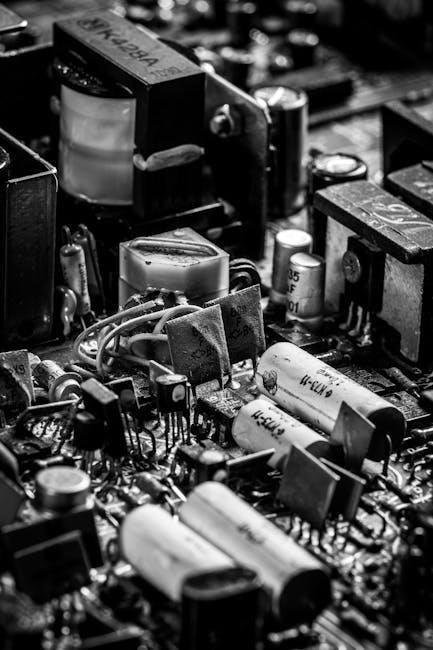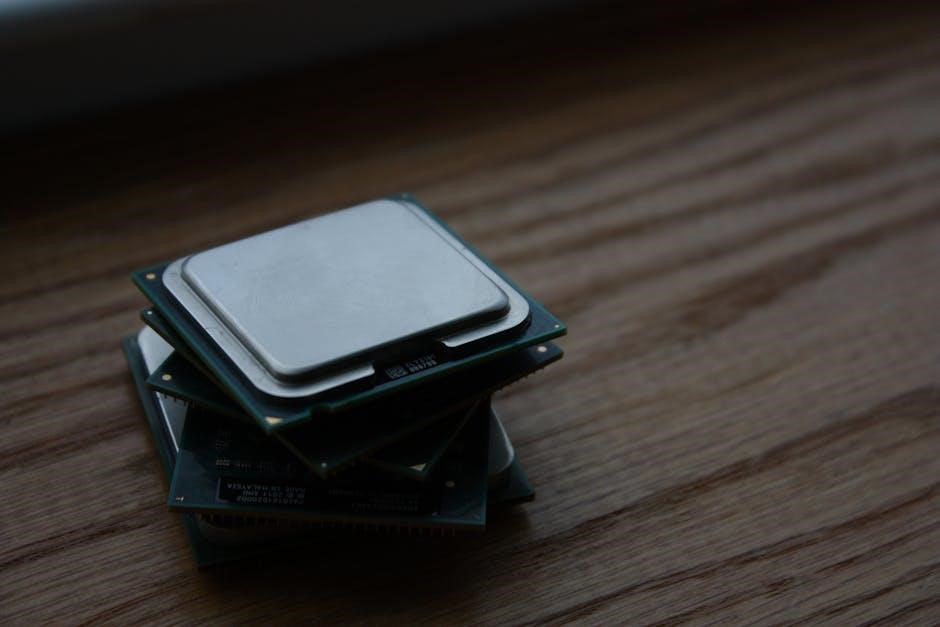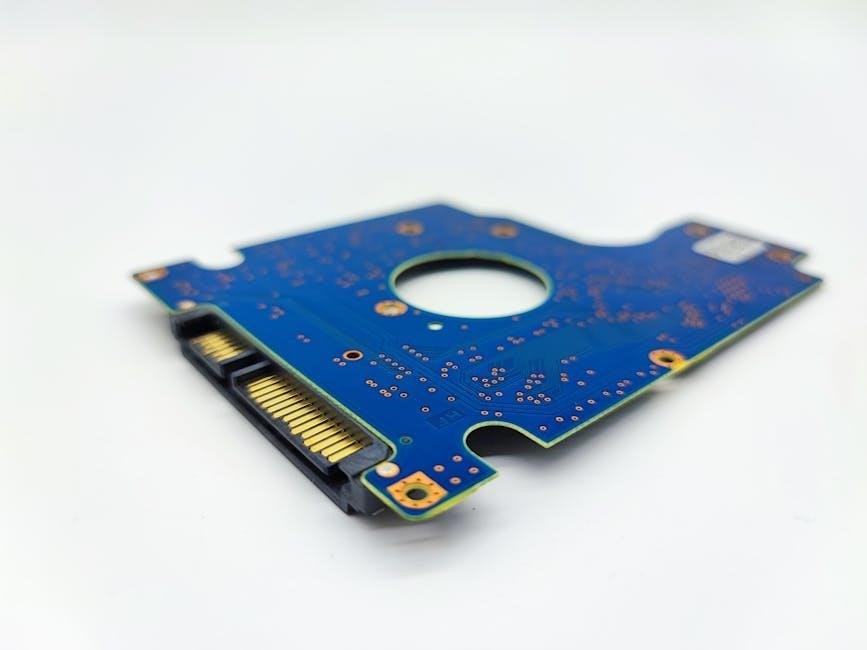A digital multimeter is an essential tool for measuring electrical parameters like voltage‚ current‚ and resistance. It offers high accuracy‚ versatility‚ and reliability in various electronic applications.
1.1 Overview of Digital Multimeters
A digital multimeter is a versatile electronic testing tool designed to measure multiple electrical properties‚ including voltage‚ current‚ resistance‚ and capacitance. It combines the functions of a voltmeter‚ ammeter‚ and ohmmeter into one device. Known for its accuracy and ease of use‚ a digital multimeter is widely used in electronics‚ engineering‚ and industrial settings. Its digital display provides precise readings‚ and its ability to switch between functions makes it an indispensable tool for diagnosing and repairing electrical circuits. This device is a cornerstone in modern electronics‚ offering reliability and efficiency for professionals and hobbyists alike.
1.2 Importance of Digital Multimeters in Electronics
Digital multimeters are indispensable in electronics for diagnosing and troubleshooting electrical circuits. Their ability to measure multiple parameters accurately ensures efficient problem-solving. By providing precise readings‚ they help maintain safety standards and prevent potential hazards. Professionals rely on them for installing‚ testing‚ and repairing electronic systems. Additionally‚ they are invaluable in educational settings for teaching electrical principles. Their versatility‚ reliability‚ and precision make digital multimeters a cornerstone in modern electronics‚ enabling users to work with confidence and accuracy across various applications.

Main Components of a Digital Multimeter
A digital multimeter contains essential components like the display screen‚ function selection knob‚ input jacks‚ fuse‚ test leads‚ and battery compartment‚ each serving specific roles.
2.1 The Display Screen
The display screen is the interface that shows measured values‚ settings‚ and modes. It typically features a high-contrast LCD for clarity. The screen displays voltage‚ current‚ resistance‚ and other parameters‚ along with units and symbols. Modern multimeters often include backlighting for better visibility in low-light conditions. The display may also show additional information like auto-ranging status or data hold functions. Its precision and readability are crucial for accurate measurements and troubleshooting. The display screen is central to the multimeter’s functionality‚ providing users with real-time data and operational feedback.
2.2 The Function Selection Knob/Dial
The function selection knob or dial is a key control that allows users to choose the desired measurement function. It typically features labeled positions for voltage‚ current‚ resistance‚ and other modes. Rotating the dial selects the appropriate function‚ ensuring accurate measurements. Some multimeters include additional settings for range selection or specialized modes. The dial’s design ensures ease of use‚ enabling quick switching between functions. Its durability and precise alignment are critical for reliable operation. The function selection knob/dial is essential for tailoring the multimeter to specific testing requirements‚ making it a fundamental control for precise measurements.
2.3 Input Jacks/Ports
Input jacks or ports are the connectors where test leads are attached to the multimeter. These ports are labeled according to their function‚ such as voltage (V)‚ current (A)‚ resistance (Ω)‚ and others. They are color-coded to match the test leads‚ ensuring proper connections. The ports allow the multimeter to measure various electrical parameters accurately. Different ports may be used for different ranges or specialized measurements. Proper use of input jacks is crucial for obtaining accurate and safe measurements. Their design ensures secure connections‚ minimizing errors and ensuring reliable data acquisition in electrical testing scenarios.
2.4 The Fuse
The fuse is a critical protective component in a digital multimeter‚ designed to prevent damage from overcurrent or voltage surges. Located internally‚ it safeguards the device and its internal circuits. If excessive current flows‚ the fuse breaks the circuit‚ ensuring the multimeter remains operational. Different fuses may be used for various functions‚ such as voltage or current measurements. Replacing a blown fuse requires care to ensure the correct rating is used‚ maintaining safety and functionality. The fuse plays a vital role in protecting both the device and the user during electrical measurements‚ making it an indispensable part of the multimeter’s design.
2.5 Test Leads
Test leads are insulated wires with probes at their ends‚ connecting the multimeter to the device under test. They are durable‚ flexible‚ and made from high-quality materials for reliability. Standard leads are suitable for most measurements‚ while heavy-duty leads are used for high-current applications. Test leads ensure accurate readings by maintaining proper contact and minimizing resistance. They are essential for voltage‚ current‚ and resistance measurements‚ providing a safe and precise connection. Proper use and maintenance of test leads are crucial for accurate and reliable multimeter performance in various electrical and electronic applications.
2.6 Battery Compartment
The battery compartment houses the multimeter’s power source‚ typically a 9V battery. It is designed to be easily accessible‚ allowing users to replace the battery when needed. The compartment is sealed to protect internal components from dust and moisture. A secure latch or screw ensures the compartment remains closed during use. The battery powers the multimeter’s digital functions‚ such as the display and internal circuitry. Proper installation and maintenance of the battery are essential for reliable operation. The compartment is a crucial part of the multimeter’s portability and functionality‚ enabling handheld use in various environments and ensuring accurate measurements.

Functions of Each Component
This section explores the specific roles of each part within a digital multimeter‚ explaining how they work together to enable precise measurements and reliable functionality in various electrical applications.
3.1 The Role of the Display Screen
The display screen is the primary interface of a digital multimeter‚ showing measured values like voltage‚ current‚ and resistance. It provides clear‚ precise readings essential for diagnosing electrical issues.
Modern displays often feature backlit screens for visibility in low-light conditions and may include auto-ranging to simplify measurements. The screen also indicates the selected function and range‚ ensuring accurate testing and troubleshooting.
3.2 Understanding the Function Selection Knob
The function selection knob is a critical component of a digital multimeter‚ enabling users to choose the desired measurement type‚ such as voltage‚ current‚ resistance‚ or continuity.
Each position on the knob corresponds to a specific function‚ ensuring precise and accurate readings. Some multimeters may also include additional settings for advanced features like temperature measurement or frequency testing.
This knob simplifies operation by allowing quick and easy switching between modes‚ making it an indispensable part of the device’s user interface and functionality.
3.3 Purpose of Input Jacks/Ports
Input jacks‚ or ports‚ are essential for connecting test leads to the multimeter. They serve as the entry point for measuring electrical parameters such as voltage‚ current‚ and resistance.
Typically‚ a multimeter has multiple input jacks‚ each designated for specific functions. The “common” jack is used for all measurements‚ while others are specialized for voltage/current or resistance testing.

Proper use of input jacks ensures accurate readings and prevents damage to the device. They are designed to securely hold the test leads‚ maintaining reliable electrical connections during measurements.
3.4 Significance of the Fuse
The fuse is a critical protective component in a digital multimeter. It acts as a safety device‚ preventing damage to the meter and ensuring user safety during measurements.
When an excessive current flows through the multimeter‚ the fuse breaks the circuit‚ protecting internal components from potential damage. This safeguard is especially important when measuring current or voltage in high-power circuits.

A blown fuse indicates an overcurrent situation‚ alerting the user to check their connections or settings before replacing it. This feature ensures reliable operation and extends the lifespan of the multimeter.
3.5 Importance of Test Leads
Test leads are essential components of a digital multimeter‚ enabling precise and safe connections to the device under test. They ensure accurate measurements by maintaining low resistance and minimizing signal interference.
High-quality test leads are durable‚ reducing wear and tear‚ and are designed to withstand various environmental conditions. Proper use of test leads is crucial for reliable readings and user safety‚ especially in high-voltage applications.
Regular inspection and maintenance of test leads are recommended to prevent errors and ensure optimal performance. They are indispensable for achieving accurate and consistent results in electrical measurements.
3.6 Function of the Battery Compartment
The battery compartment is a crucial part of a digital multimeter‚ housing the power source that enables portable operation. It securely holds the batteries‚ ensuring consistent power supply for accurate measurements.
Most multimeters use standard batteries like AA or 9V‚ which are easily replaceable. The compartment is typically designed with a secure latch to prevent accidental opening and battery loss during use.
Proper maintenance‚ such as replacing batteries when the low-battery indicator appears‚ ensures reliable performance and prevents measurement inaccuracies. A well-functioning battery compartment is essential for maintaining the multimeter’s portability and efficiency.

How to Use a Digital Multimeter
- Set up the multimeter by selecting the correct function and range.
- Connect test leads to the device being measured.
- Read and interpret the results on the display screen.
- Ensure safety by following precautions to avoid electrical hazards.
4.1 Setting Up the Multimeter
Setting up a digital multimeter involves several key steps to ensure accurate and safe measurements. First‚ turn the device off and insert the batteries into the battery compartment. Next‚ select the appropriate function using the function selection knob‚ such as voltage‚ current‚ or resistance. Choose the correct range for the measurement to optimize precision. Connect the test leads to the input jacks‚ ensuring they are securely attached. Finally‚ turn the multimeter on and allow it to initialize. Always refer to the user manual for specific setup instructions‚ and verify that the fuse is correctly rated for the selected function. Safety precautions should always be prioritized when working with electrical measurements.
4.2 Selecting the Correct Function and Range

Selecting the correct function and range on a digital multimeter is crucial for accurate measurements. Rotate the function selection knob to choose the desired mode‚ such as DC voltage‚ AC voltage‚ current‚ or resistance. Once the function is selected‚ use the range button or dial to set the appropriate scale based on the expected value. A higher range may reduce sensitivity‚ while a lower range increases precision. Always start with the highest range and adjust downward if necessary. For optimal accuracy‚ ensure the selected range aligns with the device under test. Proper function and range selection prevents damage and ensures reliable results.
4.3 Connecting the Test Leads to the Device
Connect the test leads to the multimeter by inserting the probes into the appropriate input jacks. Ensure the red lead is in the positive terminal and the black lead in the negative or common terminal. When connecting to the device under test‚ touch the probes to the correct points firmly. Avoid touching the metal tips of the probes to prevent electrical shock; For sensitive components‚ use the provided alligator clips for secure connections. Always verify the polarity and ensure no short circuits occur. Properly holding the leads ensures accurate measurements and prevents damage to the device or the multimeter.

4.4 Reading and Interpreting the Results
Once connected‚ read the measurements displayed on the multimeter’s screen. The LCD shows numerical values along with units like V‚ A‚ or Ω. Symbols may indicate settings like AUTO or HOLD. Ensure the reading aligns with the selected function. Interpret the data accurately‚ considering decimal points and unit prefixes. For example‚ 2.5V indicates 2.5 volts‚ while 2.5kΩ represents 2‚500 ohms. Verify that the range is appropriate for the measurement. If the value fluctuates‚ check connections or use HOLD to freeze the reading. Always compare results with expected values to assess the device’s performance. Consult the manual if unsure about symbols or interpretations.
4.5 Safety Precautions While Using the Multimeter
Always prioritize safety when using a digital multimeter. Wear insulated gloves and ensure the device is rated for the task. Avoid measuring voltage or current in live circuits without proper protection. Never touch probes to live components or wires. Use the correct probe tips to prevent accidental shorts. Keep the multimeter away from water and extreme temperatures. Regularly inspect test leads and fuses for damage. Ensure the multimeter is set to the correct function before connecting it to avoid damage or risk of electric shock. Follow manufacturer guidelines to ensure safe and accurate measurements. Proper precautions protect both the user and the device.
Troubleshooting Common Issues
Troubleshooting common issues with a digital multimeter involves identifying malfunctions‚ checking connections‚ and ensuring proper functionality. Regular maintenance and calibration help resolve errors and extend the device’s lifespan.
5.1 Identifying Common Problems
Common issues with digital multimeters often stem from faulty components or improper usage. These include inaccurate readings‚ damaged test leads‚ blown fuses‚ or malfunctioning input jacks. Additionally‚ screen display problems‚ such as dimming or flickering‚ can hinder functionality. Users may also encounter connectivity issues or incorrect function selection‚ leading to unreliable measurements. Identifying these problems early is crucial for maintaining the device’s accuracy and extending its lifespan. Regular maintenance and understanding the root causes of these issues help in resolving them effectively and ensuring precise measurements in various electronic applications.
5.2 Checking Connections and Leads
Checking connections and leads is vital for ensuring accurate measurements. Faulty or damaged test leads can cause incorrect readings. Regularly inspect the leads for frayed wires‚ corroded tips‚ or loose connections. Clean the input jacks and test lead tips to remove dirt or oxidation. Verify that all connections are secure and properly aligned. If a lead is damaged‚ replace it immediately to maintain measurement accuracy. Additionally‚ ensure the multimeter is turned off before checking connections to avoid any potential electrical hazards. Properly maintained leads and connections are essential for reliable performance in electronic testing and diagnostics.
5.3 Replacing the Fuse

Replacing the fuse is a common maintenance task for digital multimeters. The fuse protects the device from power surges or overcurrent situations. If the fuse blows‚ the multimeter will stop working. To replace it‚ turn off the device and disconnect it from any power source. Locate the fuse compartment‚ usually found at the rear or bottom of the multimeter. Carefully remove the blown fuse and insert a new one with the same specifications. Ensure the replacement fuse matches the voltage and current ratings to avoid further damage. Always use protective gear when handling internal components to prevent electrical shock.

5.4 Calibrating the Multimeter
Calibrating a digital multimeter ensures accurate measurements by adjusting its internal settings to match reference standards. This process is essential for maintaining precision over time. To calibrate‚ connect the test leads to a known reference source‚ such as a short circuit or a precision voltage source. Use the multimeter’s calibration menu or adjust the zero point manually‚ following the manufacturer’s instructions. Some multimeters feature auto-calibration‚ which simplifies the process. Regular calibration is crucial for reliable results‚ especially in professional or industrial settings where measurement accuracy is critical. Always refer to the user manual for specific calibration procedures.
A digital multimeter is an indispensable tool for precise electrical measurements. Its versatility and accuracy make it essential for professionals and hobbyists alike in modern electronics.
6.1 Summary of Key Points
A digital multimeter is an essential tool for measuring voltage‚ current‚ resistance‚ and other electrical parameters. Its components‚ such as the display screen‚ function selection knob‚ and test leads‚ work together to provide accurate readings. Proper use involves selecting the correct function and range‚ ensuring safe connections‚ and interpreting results effectively. Regular maintenance‚ like checking test leads and replacing fuses‚ is crucial for optimal performance. By understanding its parts and functions‚ users can harness the full potential of a digital multimeter‚ making it an indispensable asset for both professionals and hobbyists in electronics.
6.2 Final Thoughts on the Usefulness of Digital Multimeters
Digital multimeters are indispensable tools for anyone working with electronics‚ offering precision‚ versatility‚ and reliability. Their ability to measure multiple electrical parameters makes them essential for troubleshooting and diagnostics. Whether for professionals or hobbyists‚ these devices provide accurate and efficient results‚ ensuring safety and efficiency in various applications. As technology advances‚ digital multimeters continue to evolve‚ offering even greater functionality and ease of use. Their importance in modern electronics cannot be overstated‚ making them a must-have in every technician’s and engineer’s toolkit.